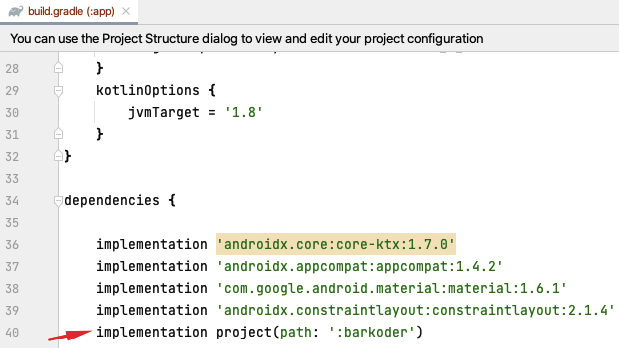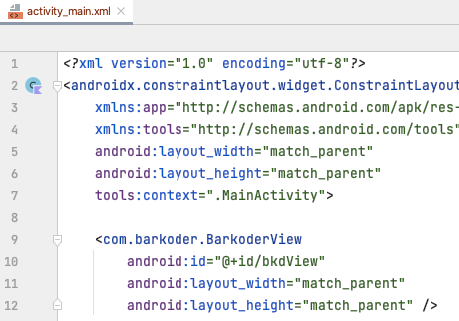Integrating the barKoder Barcode Scanner SDK into your Enterprise or Consumer-facing mobile apps will instantly transform your user's smarphones and tablets into rugged barcode scanning devices without the need to procure and maintain expensive and sluggish hardware devices that have a very short life span.
The barKoder barcode scanner SDK is a relatively new product in an established market, already developed to be as advanced if not more than other competitor API's. Its robust barcode reading engine can be used to read the content of the most widely used barcodes with lightning fast speed and unprecended recognition rate:
1D - Codabar, Code 11, Code 25, Code 39, Code 93, Code 128, EAN-8, EAN-13, Interleaved 2 of 5, ITF-14, MSI Plessey, Pharmacode, Telepen, UPC-A & UPC-E
2D - Aztec Code, Aztec Compact, Data Matrix, PDF417, Micro PDF417, DotCode, QR Code & Micro QR Code
You can check out our free demo app Barcode Scanner by barKoder available both via Apple App Store & Google Play Store.
You can find full documentation about the barKoder Barcode Reader SDK plugin for React Native here: https://docs.barkoder.com/en/v1/android-installation
To use our SDK on Android please follow these simple steps to integrate our SDK into your Android project:
Import the barkoder module like it's shown on the picture
Keep in mind that path in source directory should reference to the barcoder folder that contains both barkoder.aar and build.gradle, not directly to the barkoder.aar file
In your app's build gradle file add the following dependency
implementation project(path: ':barkoder')Add the following code to the layout.xml of the activity/fragment where you want the scanner to be shown
<com.barkoder.BarkoderView
android:id="@+id/bkdView"
android:layout_width="match_parent"
android:layout_height="match_parent" />The SDK will scan barcodes even without a license, however, certain characters will be marked with asterisks. To avoid this you can create a trial license or even a production license. Follow barkoder.com/register and create a trial license today.
Create barkoder config per your needs or from some of our templates
bkdView.config = BarkoderConfig(this, "LICENSE_KEY") {
Log.i("LicenseInfo", it.message)
}
BarkoderHelper.applyConfigSettingsFromTemplate(
this,
bkdView.config,
BarkoderConfigTemplate.INDUSTRIAL_1D,
null
)Implement BarkoderResultCallback interface where you will receive scanned results
class MainActivity : AppCompatActivity(), BarkoderResultCallback {
....
override fun scanningFinished(results: Array<Barkoder.Result>, thumbnails: Array<Bitmap>, imageResult: Bitmap?) {
Log.i("Scanned result", results[0].textualData)
}
}bkdView.startScanning(this)This code would go in your main activity, and of course it will be different for your use case, but generally it's a good starting point to have.
import android.content.res.ColorStateList
import android.graphics.Bitmap
import android.os.Bundle
import android.util.Log
import android.widget.ImageView
import android.widget.TextView
import androidx.appcompat.app.AppCompatActivity
import androidx.cardview.widget.CardView
import androidx.core.view.isVisible
import com.barkoder.Barkoder
import com.barkoder.BarkoderConfig
import com.barkoder.BarkoderView
import com.barkoder.interfaces.BarkoderResultCallback
import com.google.android.material.dialog.MaterialAlertDialogBuilder
import com.google.android.material.floatingactionbutton.FloatingActionButton
class MainActivity : AppCompatActivity(), BarkoderResultCallback {
private lateinit var txtStartScan: TextView
private lateinit var imgResult: ImageView
private lateinit var bkdView: BarkoderView
private lateinit var cardResult: CardView
private lateinit var txtResult: TextView
private lateinit var txtResultType: TextView
private lateinit var txtResultExtras: TextView
private lateinit var btnScanning: FloatingActionButton
private var isScanningActive: Boolean = false
override fun onCreate(savedInstanceState: Bundle?) {
super.onCreate(savedInstanceState)
setContentView(R.layout.activity_main)
title = "${getString(R.string.app_name)} (v${Barkoder.GetVersion()})"
txtStartScan = findViewById(R.id.txtViewStartScan)
imgResult = findViewById(R.id.imageViewResult)
bkdView = findViewById(R.id.barkoderView)
cardResult = findViewById(R.id.cardViewResult)
cardResult.setOnClickListener {
showFullResult()
}
txtResult = findViewById(R.id.textViewResult)
txtResultType = findViewById(R.id.textViewResultType)
txtResultExtras = findViewById(R.id.textViewResultExtras)
btnScanning = findViewById(R.id.buttonScanning)
btnScanning.setOnClickListener { onBtnScanningClick() }
createBarkoderConfig()
setActiveBarcodeTypes()
setBarkoderSettings()
}
override fun onStop() {
isScanningActive = false
updateUI()
super.onStop()
}
private fun createBarkoderConfig() {
// In order to perform scanning, config property needs to be set before
// If license key is not valid you will receive results with asterisks inside
bkdView.config = BarkoderConfig(this, "LICENSE_KEY") {
Log.i("Licensing SDK: ", it.message)
}
}
private fun setActiveBarcodeTypes() {
// There is an option to set multiple active barcodes at once as array
bkdView.config.decoderConfig.SetEnabledDecoders(
arrayOf(
Barkoder.DecoderType.QR,
Barkoder.DecoderType.Ean13
)
)
// or configure them one by one
bkdView.config.decoderConfig.UpcA.enabled = true
}
private fun setBarkoderSettings() {
// These are optional settings, otherwise default values will be used
bkdView.config.let { config ->
config.isImageResultEnabled = true
config.isLocationInImageResultEnabled = true
config.isRegionOfInterestVisible = true
config.isPinchToZoomEnabled = true
config.setRegionOfInterest(5f, 5f, 90f, 90f)
}
}
private fun updateUI(result: Barkoder.Result? = null, resultImage: Bitmap? = null) {
if (isScanningActive) {
txtStartScan.isVisible = false
btnScanning.backgroundTintList =
ColorStateList.valueOf(resources.getColor(R.color.primary))
} else {
txtStartScan.isVisible = resultImage == null
btnScanning.backgroundTintList =
ColorStateList.valueOf(resources.getColor(R.color.black))
}
txtResultType.text = result?.barcodeTypeName
txtResult.text = result?.textualData
showResultExtras(result)
imgResult.setImageBitmap(resultImage)
imgResult.isVisible = resultImage != null
}
private fun onBtnScanningClick() {
if (isScanningActive) {
bkdView.stopScanning()
} else {
// Starting the scanning process and set BarkoderResultCallback where read results will be received
// @throw NPE if config is not set before
bkdView.startScanning(this)
}
isScanningActive = !isScanningActive
updateUI()
}
override fun scanningFinished(results: Array<Barkoder.Result>, thumbnails: Array<Bitmap>, resultImage: Bitmap?) {
isScanningActive = false
if (results.isNotEmpty())
updateUI(results[0], resultImage)
else
updateUI()
}
private fun showResultExtras(result: Barkoder.Result?) {
if (result?.extra?.isNotEmpty() == true) {
val extras = StringBuilder()
result.extra.forEach {
extras.append("${it.key}: ").append(it.value).appendLine()
}
txtResultExtras.text = extras.toString().trimEnd()
} else
txtResultExtras.text = ""
}
private fun showFullResult() {
if (!txtResult.text.isNullOrBlank()) {
MaterialAlertDialogBuilder(this)
.setTitle(R.string.result_title)
.setMessage(txtResult.text)
.setPositiveButton(android.R.string.ok, null)
.show()
}
}
}Reference for the BarkoderView class
Set camera frames callback if you want to receive the frames/images only without decoding them and do your own work with the frames. Don't forget to close the image at the end
- @param previewFramesCallback
fun setPreviewFramesCallback(previewFramesCallback: BarkoderPreviewFramesCallback)Get maximum zoom factor that can be set for the camera preview Zoom factor is received in MaxZoomAvailableCallback
- @param callback MaxZoomAvailableCallback
fun getMaxZoomFactor(callback: MaxZoomAvailableCallback)Set zoom factor for the camera preview. If preview session is already active this zoom factor will be set only for this session, otherwise initial zoom will be set. Every next preview session will be started with this zoom factor.
- @param zoomFactor [1, maxZoomFactor]. Default value is 1
fun setZoomFactor(zoomFactor: Int)Check if current mobile device has flash available Result is received in FlashAvailableCallback.
- @param callback
fun isFlashAvailable(callback: FlashAvailableCallback)Turn flash ON/OFF If preview session is already active this state be set only for active session, otherwise the initial flash state is set. Every next preview session will be started with this state.
- @param enabled [true, false]. Default value is false.
fun setFlashEnabled(enabled: Boolean)Stop the camera preview session and decoding if active
fun stopCamera()Start the camera preview (if is not already running) and the scanning process
- @param resultCallback @throw NullPointerException if BarkoderView config is not set
fun startScanning(resultCallback: BarkoderResultCallback)Stop the scanning process and the camera preview
fun stopScanning()Pause only the scanning process. Camera preview is still running
fun pauseScanning()Get the decoder config object. With this object you can enable/disable decoders (barcode types) or configure each one of them @return Barkoder.Config object
fun getDecoderConfig(): Barkoder.ConfigGet the location line color as integer
- @return location line color
fun getLocationLineColor(): IntSet the location line color as integer. This line is used for marking the scanned barcode in the image result
- @param locationLineColor [valid color representation as integer]. Default value is Color.GREEN
fun setLocationLineColor(locationLineColor: Int)Get the location line width as float.
- @return location line width
fun getLocationLineWidth(): FloatSet the location line width as float. This line is used for marking the scanned barcode in the image result
- @param locationLineWidth. Default value is 4.0
fun setLocationLineWidth(locationLineWidth: Float)Get the region of interest line color as integer
- @return roi line color
fun getRoiLineColor(): IntSet the region of interest line color as integer
- @param roiLineColor [valid color representation as integer]. Default value is Color.RED
fun setRoiLineColor(roiLineColor: Int)Get the region of interest line width as float
- @return roi line width
fun getRoiLineWidth(): FloatSet the region of interest line width as float
- @param roiLineWidth. Default value is 3.0
fun setRoiLineWidth(roiLineWidth: Float)Get the region of interest background color as integer
- @return roi overlay background color
fun getRoiOverlayBackgroundColor(): IntSet the region of interest line color as integer
- @param roiOverlayBackgroundColor [valid color representation as integer]. Default value is 40% transparency
fun setRoiOverlayBackgroundColor(roiOverlayBackgroundColor: Int)Check if camera preview session will be closed when barcode is scanned
- @return true if preview will be closed, false otherwise
fun isCloseSessionOnResultEnabled(): BooleanSet if camera preview session should be closed when barcode is scanned
- @param closeSessionOnResultEnabled [false, true]. Default is true
fun setCloseSessionOnResultEnabled(closeSessionOnResultEnabled: Boolean)Check if the image result is enabled. Image result is received in BarkoderResultCallback as Bitmap
- @return true if enabled or false if is not enabled
fun isImageResultEnabled(): BooleanSet if image result is enabled, otherwise null will be received
- @param imageResultEnabled [false, true]. Default is false
fun setImageResultEnabled(imageResultEnabled: Boolean)Check if barcode location in the image result is enabled. If enabled, barcode in the result image will be marked
- @return true if enabled or false if is not enabled
fun isLocationInImageResultEnabled()Set if scanned barcode in the image result should be marked
- @param locationInImageResultEnabled [false, true]. Default is false
fun setLocationInImageResultEnabled(locationInImageResultEnabled: Boolean)Get active region of interest @return Barkoder.BKRect object
fun getRegionOfInterest(): Barkoder.BKRectSet region of interest in percentage @param left. Default 3% @param top. Default 20% @param width. Default 94% @param height. Default 60% @throw IllegalArgumentException if input params are not valid
fun setRegionOfInterest(left: Float, top: Float, width: Float, height: Float)Get maximum threads that are used for the decoding process @return threads number as integer
fun GetThreadsLimit(): IntSet maximum threads that will be used for the decoding process @param threadsLimit [1, max threads available] @throw IllegalArgumentException if input param is greater than maximum threads available on that device
fun SetThreadsLimit(threadsLimit: Int)Check if barcode location in preview is enabled. If enabled, scanned barcode will be marked on the preview screen for short time @return true if enabled or false if is not enabled
fun isLocationInPreviewEnabled(): BooleanSet if scanned barcode should be marked on the preview screen for short time @param locationInPreviewEnabled [true, false]. Default is true
fun setLocationInPreviewEnabled(locationInPreviewEnabled: Boolean)Check if the camera preview can be zoomed with pinch @return true if enabled or false if is not enabled
fun isPinchToZoomEnabled(): BooleanEnable or disable pinch to zoom on the camera preview @param pinchToZoomEnabled [true, false]. Default is false
fun setPinchToZoomEnabled(pinchToZoomEnabled: Boolean)Check if ROI is visible on the preview screen @return true if visible or false otherwise
fun isRegionOfInterestVisible(): BooleanSet if ROI should be visible on the preview screen @param regionOfInterestVisible [true, false]. Default is true
fun setRegionOfInterestVisible(regionOfInterestVisible: Boolean)Get the active resolution. It can be Normal(HD), or HIGH(Full HD) @return BarkoderResolution object
fun getBarkoderResolution(): BarkoderResolutionSet the camera resolution that will be used while scanning @param barkoderResolution [BarkoderResolution.NORMAL, BarkoderResolution.HIGH]. Default is BarkoderResolution.NORMAL
fun setBarkoderResolution(barkoderResolution: BarkoderResolution)Check if device will beep on successful scan @return true if enabled or false if is not enabled
fun isBeepOnSuccessEnabled(): BooleanSet if device should beep on successful scan @param beepOnSuccess [true, false]. Default is true
fun setBeepOnSuccessEnabled(beepOnSuccess: Boolean)Check if device will vibrate on successful scan @return true if enabled or false if is not enabled
fun isVibrateOnSuccessEnabled(): BooleanSet if device should vibrate on successful scan @param vibrateOnSuccess [true, false]. Default is true
fun setVibrateOnSuccessEnabled(vibrateOnSuccess: Boolean)Find out more:


